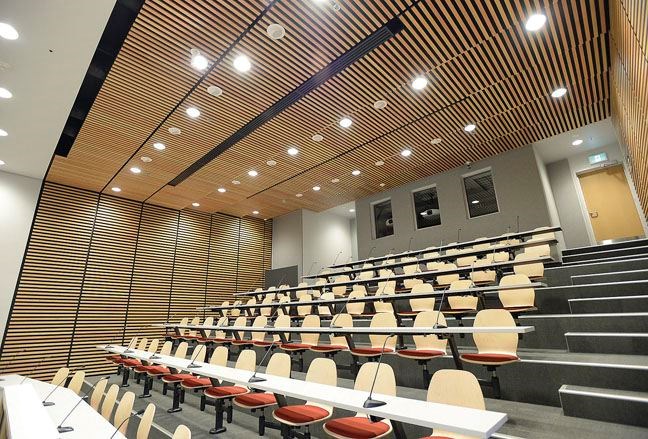At 29.5 metres, the Wood Innovation and Design Centre in Prince George isn't that tall in conventional building terms - officially six floors, but topping out at a height of about eight storeys.
As a wooden structure, however, the centre is anything but conventional.
It is a towering example of all-wood construction, which, for better or worse, now stands as the province's poster building and ambassador for promoting the use of innovative techniques and products for constructing tall structures made out of B.C. wood.
"It's kind of a perfect showcase," said Guido Wimmers, the newly hired University of Northern B.C. professor who heads a unique wood design program that will be taught out of the building.
"It is bragging a little bit in terms of showing off the material. Everything is transparent and you can actually see how it was built."
That means showing off the cross-laminated timbers and panels, made by Penticton's Structurlam Products Ltd., the envelope-pushing designs of visionary architect Michael Green and structural building techniques that will allow wood builders to reach for the sky in terms of height.
Built by the province at a cost of $25 million, WIDC opened last month as a more modest manifestation of grandiose promises of former premier Gordon Campbell, dating back to 2009, which once envisioned a $161-million, 10-storey block-long highrise that would be the focal point for educational programs housing 420 students.
Wimmers' program, the master of integrated wood design in UNBC's engineering department, will take perhaps 10 students in its first group next year, growing to between 30 and 45 students in courses that will occupy three floors of the WIDC building.
The program, however, will be leading edge and graduates will be in demand in the growing field of sustainable design where wood is prized for its carbon-sequestering properties. And WIDC is still the tallest contemporary all-wood building in North America.
"It stands as an example of the possibilities [for using] wood in British Columbia," said Shirley Bond, Minister of Jobs, Tourism and Skills Training, and MLA for the Prince George constituency that is WIDC's home.
"Yes, it's not as big as we'd have assumed at the beginning, but the building is substantive, it is visually impressive in our community and the program UNBC is offering is going to make a difference in terms of working with wood in B.C." Bond added.
Early development was also caught in political wrangling over the land assembly for the project, elements of which are still working their way through the courts in Prince George.
When it was finally launched, however, some 13 companies worked on the Wood Innovation and Design Centre, and 20 contributed to the project in total including all consultants, designers, engineers and suppliers.
And it is already paying dividends for some of them, including key architect Michael Green's firm.
"As a legacy project, this has kicked off and become a stepping stone for other projects to follow," said Carla Smith, an associate at Michael Green Architecture, and lead architect on WIDC's design team.
Green's firm is at work now on the design for a seven-storey, 200,000-square-foot all-wood office building in the U.S., and WIDC helped put "lots of tools in our tool box" for subsequent designs, Smith said, including its own best-practices guide.
And the building process included proving that the innovative joint assemblies of its cross-laminated timber walls and panels would maintain the one-hour fire separation standards required by B.C.'s building codes, she added.
And coming in on budget offered reassurance to the commercial construction sector that isn't always excited about being at the front end of innovation.
"What WIDC has also partly done, as a leading-edge, bleeding-edge project, is to prove out to the private sector that this could be done affordably," Smith said.
She added that the systems and techniques used in WIDC illustrate in real-world terms the concepts Green and engineer Eric Karsh presented in their 2012 paper, The Case for Tall Wood Buildings.
"There are technical challenges, but the systems we used on WIDC could be used, without much modification, to go to 20, 30 storeys," Smith said.
However, WIDC also serves the more prosaic purpose of demonstrating the all-wood construction techniques using mass-and-timber techniques appropriate for mixed-use commercial construction, that will likely show up in future editions of Canadian building codes, according to Lynn Embury-Williams, executive director of WoodWorks BC, a non-profit agency aimed at promoting the use of wood products in design.
"We have residential six-storey buildings now being built in wood frame," Embury-Williams said. "The next stage are mixed-use buildings, and those types of buildings will be able to use some of the same [building] systems [as WIDC]."
Embury-Williams added that the UNBC integrated wood design program is also an important element to the project.
"It establishes a base of education right here in B.C., and it sits in a building that is the living lab [for wood construction]," she said.
Smith added that the educational component gives the centre a "nice full-circle story," leading to future innovations in wood construction, which is another legacy.
For Wimmers, one of his hopes is that WIDC helps promote more secondary manufacturing of wood products in B.C., which is something the province's forest industry could use at a time when it is bracing for more consolidation and job losses due to constraints on B.C.'s medium-term timber supply.
"I have a European background, and the classic sawmill [there] is dead," Wimmers said. "They all have to start adding value to products, and that happened over the last 15-20 years. Now, we're pretty much at the same point in Canada."



